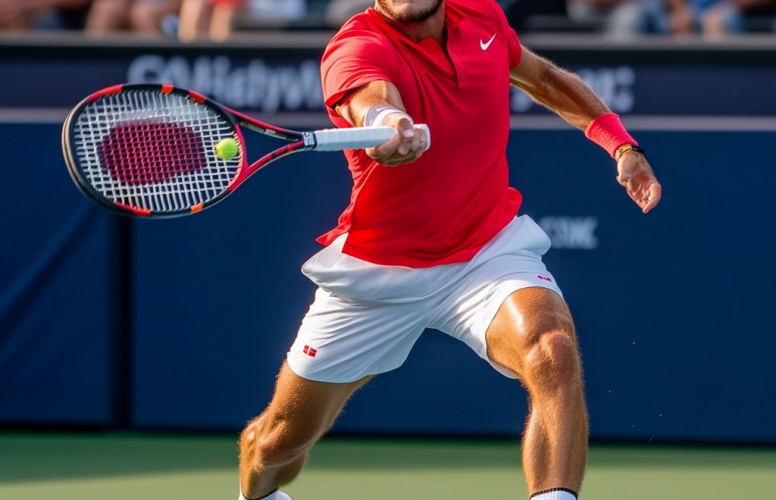The journey to becoming a top tennis player involves more than raw talent and physical ability. Canadian tennis stars have been making waves on the global stage, and their preparation habits play a critical role in their success. From mental conditioning to personalized routines, their approach offers valuable insights for aspiring athletes and enthusiasts.
The Power of Mental Conditioning
Tennis is as much a mental game as it is a physical one. Canadian players like Bianca Andreescu and Felix Auger-Aliassime emphasize the importance of mental toughness to navigate the highs and lows of competitive play.
Techniques for Mental Strength
- Visualization: Many Canadian players practice visualization, imagining themselves succeeding in crucial moments during matches. This helps them stay confident under pressure.
- Meditation and Mindfulness: Regular meditation aids in improving focus and reducing anxiety before high-stakes games. Techniques such as mindful breathing are widely adopted.
Beyond these techniques, maintaining a positive mindset is crucial. Bianca Andreescu’s mantra, “Believe in yourself,” reflects the core of mental conditioning: confidence and self-assurance.
Tailored Fitness Regimens
A player’s physical preparation is key to enduring the grueling demands of the sport. Canadian tennis professionals adhere to personalized fitness routines that cater to their unique needs and playing styles.
Core Components of Training
- Endurance Building: Long matches require excellent stamina. This involves cardio exercises such as running and cycling.
- Strength Training: Developing core and upper body strength is vital for powerful serves and groundstrokes.
- Flexibility and Recovery: Yoga and dynamic stretching help prevent injuries and promote quicker recovery after intense sessions.
Felix Auger-Aliassime often highlights the importance of balancing strength with agility, ensuring that movements remain fluid and responsive.
Strategic Diet and Nutrition
Fueling the body effectively is essential for optimal performance. Canadian players work with professional nutritionists to design meal plans that align with their training schedules and match day requirements.
Key Elements of a Winning Diet
- Balanced Macronutrients: Proteins for muscle repair, carbohydrates for energy, and healthy fats for endurance.
- Hydration: Staying hydrated with water and electrolyte-rich drinks is non-negotiable.
- Game-Day Foods: Many players rely on light, energy-boosting snacks such as bananas or energy bars before matches.
Maintaining consistency in nutrition ensures players are always ready to deliver their best, no matter the conditions.
Perfecting Pre-Match Routines
Pre-match preparation sets the tone for performance on the court. Canadian players often follow meticulously crafted routines that help them enter a focused and confident state.
Common Pre-Match Rituals
- Dynamic Warm-Ups: These include light jogging, stretches, and tennis-specific drills to activate muscles.
- Mental Focus: Listening to favorite music or reviewing strategies with coaches helps players concentrate.
- Equipment Check: Ensuring racquets, grips, and accessories are in perfect condition to avoid any distractions during the match.
These routines not only prepare players physically but also help them mentally transition into competitive mode. The consistency of such rituals contributes to their ability to perform under varying conditions.
Building a Support Network
Behind every successful tennis player is a dedicated team that provides guidance, support, and expertise. Canadian players prioritize assembling a reliable support network to enhance their preparation and performance.
Coaches, trainers, physiotherapists, and nutritionists work together to ensure that every aspect of the player’s training is optimized. This collaborative approach allows athletes to focus on their game without unnecessary distractions.
Key Roles in the Support Team
- Coach: Develops tailored strategies and provides critical feedback.
- Trainer: Focuses on physical conditioning and injury prevention.
- Physiotherapist: Helps with recovery and addresses any physical issues.
- Nutritionist: Designs meal plans for peak performance.
Having such a team not only improves performance but also provides emotional and mental stability during challenging times.
Adapting to Different Surfaces
One of the unique aspects of tennis is the variety of court surfaces—hard, clay, and grass—each demanding different playing styles. Canadian players dedicate significant time to mastering these surfaces to ensure versatility in their game.
On clay courts, they focus on endurance and patience, while on grass, they emphasize quick reflexes and precision. Training sessions are tailored to simulate the conditions of upcoming tournaments, helping players adapt seamlessly.
Tips for Surface Adaptation
- Practice specific footwork for each surface to improve movement.
- Adjust equipment, such as string tension and shoe grip, to suit the surface.
- Analyze matches of top players on different courts to gain strategic insights.
This adaptability has been a key factor in the success of Canadian players on the global stage.
Leveraging Technology and Analytics
Modern tennis has embraced technology, and Canadian players are at the forefront of using analytics to gain a competitive edge. Data-driven insights provide valuable information on opponents, playing patterns, and areas for improvement.
Tools and Techniques
- Video Analysis: Reviewing match footage to refine techniques and strategies.
- Wearable Devices: Monitoring performance metrics like heart rate, speed, and recovery time.
- Statistical Analysis: Identifying strengths and weaknesses through match statistics.
These tools not only enhance performance but also contribute to smarter training and preparation.
Maintaining Work-Life Balance
While professional tennis demands intense focus and commitment, maintaining a healthy work-life balance is essential for long-term success. Canadian players often highlight the importance of taking time off to recharge and spend with family and friends.
Balancing personal interests with professional obligations prevents burnout and ensures a more fulfilling career. This holistic approach is integral to sustaining motivation and passion for the sport.
Inspiring the Next Generation
Canadian tennis players understand their role as ambassadors of the sport. By sharing their stories and engaging with fans, they inspire young athletes to pursue their dreams. Many players participate in community programs and mentorship initiatives, making the sport more accessible and encouraging future talent.
Ways They Give Back
- Hosting youth tennis clinics to share skills and knowledge.
- Partnering with organizations to promote sports in underprivileged areas.
- Using social media to connect with fans and provide motivational insights.
This commitment to fostering the next generation cements their legacy both on and off the court.
Questions and Answers
Canadian players use techniques such as visualization, meditation, and maintaining a positive mindset to enhance their mental toughness.
Each court surface demands unique playing styles, so mastering them helps players perform well in diverse tournament conditions.
Technology provides tools like video analysis, wearable devices, and statistical insights, allowing players to refine strategies and improve performance.

